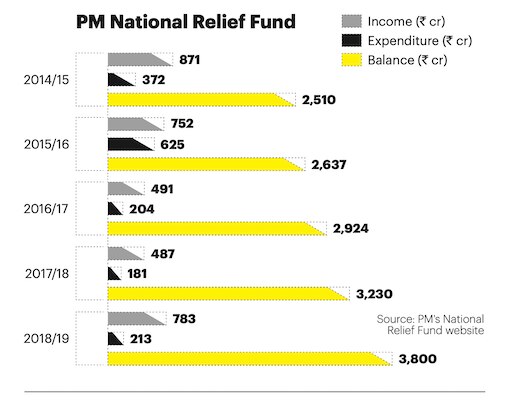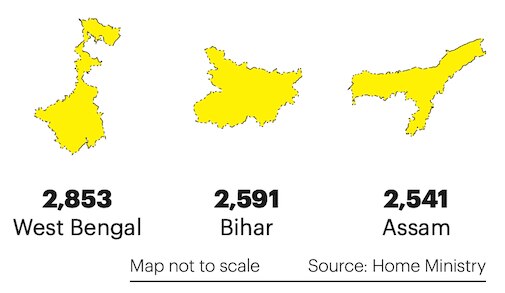Funding Disaster Relief

With over 4,200 positive cases and 220 deaths - numbers that are only increasing day by day - and revenue expected to take a massive hit due to the 40-day lockdown, Maharashtra, the worst-affected state in the Covid-19 pandemic, is in desperate need of funds for testing, lab equipment, quarantining and other relief work.
It is not alone.
States across the country will need to be handheld in terms of funds, with resources pooled in from across Central and state ministries to help tackle a pandemic of this proportion. The question then is, are there dedicated funds to address the situation?
The Options Available
The focus currently is on the Prime Minister's Citizen Assistance and Relief in Emergency Situations Fund (PM CARES Fund), a new trust constituted by Prime Minister Narendra Modi to mobilise resources through donations to fight the coronavirus outbreak. However, the Centre and states already have a separate fund - not dependent on donations but budgetary allocations - for relief and rehabilitation work in case of a disaster. The fund has two parts - the State Disaster Response Fund (SDRF) and the National Disaster Response Fund (NDRF). Together, they have a size of Rs 32,000 crore, of which close to Rs 29,000 crore is with states under SDRF.

While SDRFs comprise the bulk of the fund allotted by the Centre for disaster management, donation-based funds such as the Prime Minister's National Relief Fund and the Chief Minister's Relief Fund are other sources.
Take the example of Maharashtra. The state is staring at a serious fund crunch - Goods and Services Tax (GST) collection has already plunged by Rs 27,000 crore in March itself, and State Home and Finance Minister Ajit Pawar has written to Prime Minister Modi, demanding a Central grant of Rs 10,000 crore a month for the next five months.
Maharashtra received around Rs 1,611 crore, the first instalment of the Centre's share of the SDRF, on April 3. Besides, it has made a provision of Rs 10,744 crore for expenses towards natural calamities, a part of which can now be used to fight the coronavirus outbreak. Apart from that, in the last two months, the Maharashtra Chief Minister's Relief Fund has received donations worth Rs 200 crore.
SDRFs and NDRF: Responding to Disasters
So, in India, states and the Centre share the responsibility of disaster risk financing, with states playing the main role in responding to such situations through relief, rehab and reconstruction work, and the Centre providing support in the form of additional funding and assistance. State governments bear most of the disaster-related expenses through SDRFs, and these funds are "augmented and replenished" through NDRF.
The allocation to SDRFs is decided by the Finance Commission, and the contribution is made by the Centre and states in a 75:25 ratio. For hilly areas, the Central government's contribution is 90 per cent. The allocation to SDRFs depend on factors, including expenditures incurred by states on disaster management, and area, population and risk prople of individual states.

The total allocation to SDRFs is Rs 28,983 crore for 2020/21, according to the 15th Finance Commission, of which the Centre's share is Rs 22,184 crore. The Centre's share of SDRFs comes from home and finance ministries as part of their Budget allocations under the head - Relief on Account of Natural Calamity.
The NDRF draws a part of its fund through direct transfer of the National Calamity Contingent Duty (NCCD) levied by the Centre on certain goods such as tobacco, tobacco products and petroleum products. In 2020/21, the government has budgeted Rs 2,930 for transfer to the NDRF through the NCCD.
"Whether a disaster happens or not, this money is always available with state governments to combat a possible crisis," says GVV Sarma, Member Secretary, National Disaster Management Authority (NDMA), the nodal agency that coordinates with State Disaster Management Authorities and develops a strategy for prevention of disasters.
Sarma told Business Today that the home ministry has already asked for a part of SDRFs to be utilised for coronavirus-related works. It has also relaxed certain restrictions on the use of SDRFs, including the criterion of using 40 per cent funds for response and relief work, 30 per cent on recovery and reconstruction and 10 per cent on preparedness and capacity building. Also, the first instalment of the Centre's share of SDRFs - Rs 11,092 crore - for 2020/21 is being released earlier due to the coronavirus outbreak. The Centre normally releases its contribution in two instalments.

Explains Sarma of NDMA: "If a calamity or a disaster of a very big nature happens, state governments normally prepare a memorandum and send it to Central government. The Centre will send an inter-ministerial panel chaired by the home secretary to the affected state, which will then give its recommendations. After this, another committee is formed under the home minister, which will make recommendations for further allocations (to states) through the NDRF. In case of Covid-19, we have not come to that stage yet."
Donations to Relief Funds
The PM National Relief Fund (PMNRF) as well as the CM Relief Funds are public charitable trusts governed by the Public Trust Act of states and the Indian Trusts Act, 1882. Most CM Relief Funds are governed by state trust acts. The Maharashtra CM's Relief Fund, for example, is governed by the Bombay Public Trust Act, 1950.
According to its website, the resources of the PMNRF are utilised primarily for offering immediate relief to families of those killed in natural calamities such as floods, cyclones and earthquakes, and to victims of major accidents and riots. In the last five years, the PMNRF has received annual donations to the tune of Rs 450-900 crore, and incurred annual expenses of Rs 250-600 crore. The excess fund is invested in bonds and fixed deposits (FDs). The PMNRF had a balance of Rs 3,800 crore at the end of March 2019.
Due to the severity of the coronavirus outbreak, the Centre constituted the PM CARES Fund. It has been set up as a public charitable trust, which will receive donations from the public as well as institutions, and the money will be used only to fight the coronavirus pandemic.
While many have questioned the need for an exclusive fund for coronavirus despite the existence of the PMNRF, Gyaneshwar Kumar Singh, Joint Secretary, Ministry of Corporate Affairs, says the new fund was created since there were several representations for an exclusive fund (to fight Covid-19).

The criticism surrounding the PM CARES Fund is primarily because the government is yet to come out with any details about the fund, except that it has been set up as a public charitable trust, and the prime minister is the chairman of the trust with the defence, home and finance ministers as members.
Besides, its similarities with the PMNRF - both have been constituted as charitable trusts and through an Act of Parliament, both have the Prime Minister as the chairman of the trusts, donations to both are eligible for tax exemptions and their corporate social responsibility (CSR) status - makes it, according to a number of people, only a clone of the PMNRF.
Preeti Malhotra, who is currently chairing the ASSOCHAM National Council on corporate affairs, corporate governance and CSR, says there was no need for a separate trust, and a separate fund for coronavirus could have been created within the PMNRF.
In fact, there are different heads under some CM Relief Funds. The Maharashtra CM's Relief Fund, for example, collects funds for specific purposes, including coronavirus, Jalyukta Shivar, Farmers Fund, Drought Fund, etc. Even the Kerala CM Distress Relief Fund asks for donations under different heads such as Covid-19, floods, etc.
However, some find the criticism unfounded. "Coronavirus has impacted people across the country, and the PM CARES Fund attaches a cause to it. Everyone is feeling for this cause. An earthquake in Andaman or a storm in Odisha is not something for which people would have the same level of concern as that of a pan-India disaster like coronavirus. Hence, a separate fund for relief measures makes perfect sense," says Mohit Chaudhary, a Supreme Court lawyer and managing partner of law firm Kings and Alliance.
Helping Hand from Global Agencies
International agencies, including the World Bank and the Asian Development Bank (ADB), also provide support in case of a calamity or disaster of severe nature. Both institutions have already extended financial support in the country's fight against the current pandemic.
The World Bank recently approved a $1-billion financial support to help "India prevent, detect, and espond to the Covid-19 pandemic and strengthen its public health preparedness". This, according to the statement issued by the World Bank, is the largest ever health sector support from the lending agency to India. ADB is also preparing a $2.2-billion assistance for the Indian health sector.

"All these multilateral agencies provide additional funds, a part of which also goes to states," says Arindam Guha, Partner, Deloitte.
Sometimes, states themselves also raise funds directly from these global agencies through their respective State Disaster Management Authorities in case of a disaster of a very severe nature. For exa-mple, the reconstruction and rehabilitation work after the 2001 Gujarat earthquake was funded by both the World Bank and ADB. The two agencies had together pooled in over $900 million.
According to Guha of Deloitte, states can also explore insurance as part of their overall disaster risk financing strategy, especially in cases where calamities such as cyclones are common.
So, given the severity of natural and man-made calamities and their frequent occurrences, it is only pertinent and prudent to have a robust funding system for disaster management, which does not only depend on donations or debts. A higher allocation to SDRFs, better monitoring of fund use, and exploring newer avenues would make for a fool-proof disaster management financing strategy for any country, including India.
@dipak_journo










